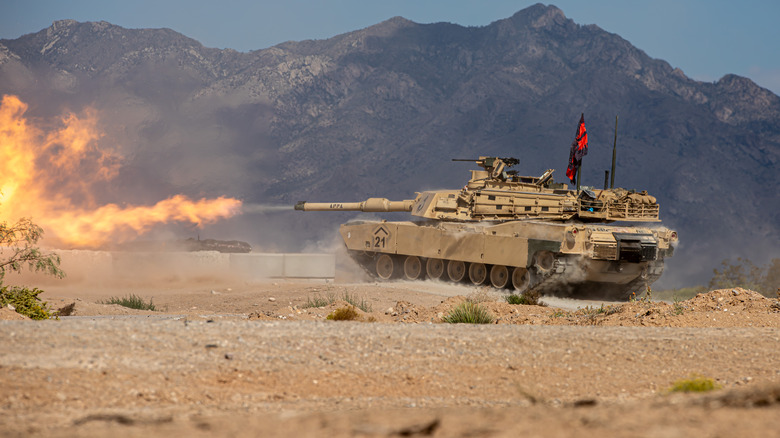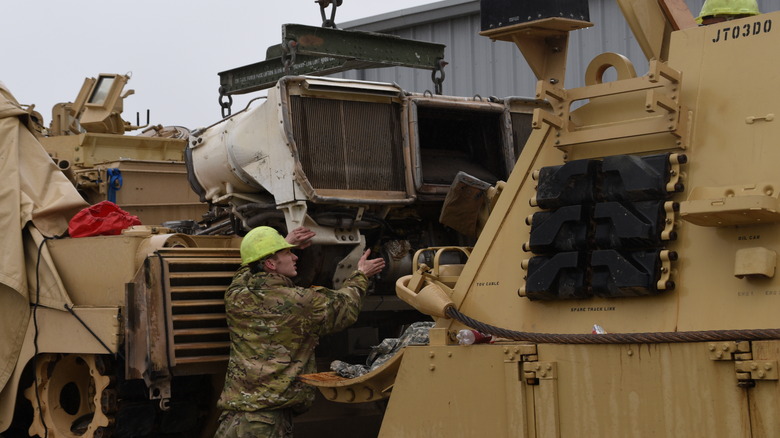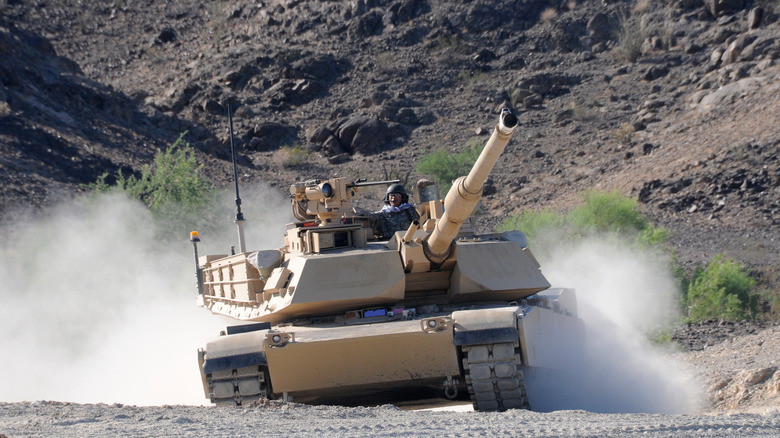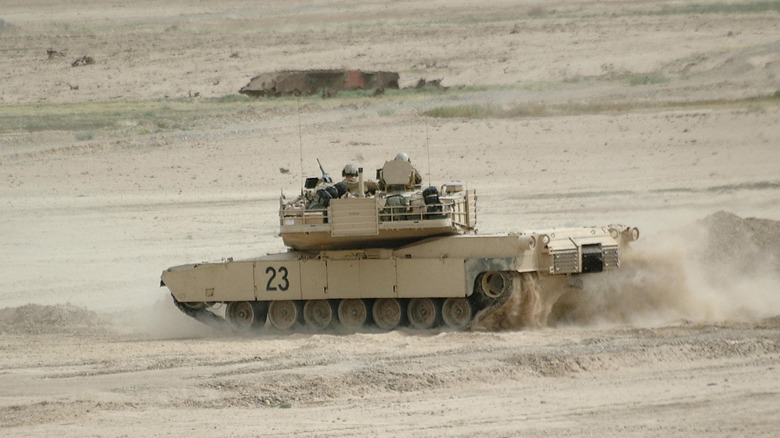Here's Why The M1 Abrams Tank Uses A Gas Turbine Instead Of A Diesel Engine
Since its introduction in 1980, the M1 Abrams has been the symbol of American ground firepower. Even after nearly four decades of service, including combat operations from the deserts of Iraq during the Gulf War to the current conflict in Ukraine, the M1 is still regarded as one of the world's greatest Main Battle Tanks (MBTs).
The M1 Abrams' reputation is not solely due to its status as one of the most widely produced tanks in the world (with over 10,000 units in various versions and upgrades). Nor is it because it is the primary armored workhorse of the illustrious U.S. military. The M1 Abrams has earned its acclaim by being the "few among many" in many facets of its design. It's one of the first tanks to feature composite Chobham armor and later enhanced depleted uranium armor. Then, the Abrams stands out from most other MBTs with its unique powerplant: the Avco-Lycoming AGT1500 gas turbine engine.
While most tanks in the arsenals of other countries run on diesel engines, from Britain's newest Challenger 3 to the German Leopard-2 series, and the Russian T-90M, the Abrams is an outlier. Some exceptions exist, like most versions of the Soviet T-80 tank (except for the diesel-running T-80UD variant), but the Abrams is undoubtedly a special case in the world of tanks. So, what led to this peculiar engine choice?
Full Torque Ahead
If you've ever flown on a plane, you've seen a gas turbine engine in action. All modern aviation turbofans are essentially massive gas turbine engines. These aren't much different from the M1's engine.
The AGT1500 gas turbine engine works by using an air inlet to draw in air. This air is then compressed, mixed with fuel, and combusted, creating a hot, fast-moving flow of gas. This gas flow is used to drive a series of turbines connected to the tank's sprockets, which in turn propels the tank's tracks. The engine also generates power for the tank's electronics and other systems like hydraulics through an accessory gearbox.
Compared to a diesel engine, like the MTU MB 883 Ka-500 powerplant, the M1's gas turbine can produce far more torque and horsepower at lower engine speeds. This translates to excellent acceleration from a standstill. Despite weighing an incredible 68 tons, the M1 Abrams can go from 0 to 20 mph in just 6 seconds, with a top speed of 45 mph.
This impressive mobility not only gives the M1 an advantage on the battlefield but also allows it to carry significantly more armor protection than most other tanks. In addition to its built-in Chobham or depleted uranium armor (depending on the version), the M1 can be equipped with additional appliqué (add-on) armor plates as needed, such as the reactive armor tiles and slat armor ring around the turret seen on the Tank Urban Survival Kit (TUSK) upgrade.
If It's Combustible, It'll Do for the Abrams
Just like a typical jet aircraft, the M1 Abrams, whenever possible, is fed with jet fuel. However, when there's a supply constraint, the engine can also be fed with diesel... and marine diesel, and gasoline, even kerosene. Anything combustible can be fed into the Abrams, and it'll run just fine.
Supply lines for jet fuel to forward operating bases may not always be consistent. In such cases, more readily available diesel fuel can be sourced locally to keep the tanks running.
This multi-fuel capability also gives the M1 Abrams an edge in extreme environmental conditions. For example, diesel-powered tanks may struggle in arctic conditions due to diesel's relatively low freezing point of 32 to 15 degrees Fahrenheit. By switching to jet fuel or kerosene, which have lower freezing points, the Abrams can maintain its combat effectiveness in even the harshest of cold weather operations.
However, this impressive fuel flexibility does come with a trade-off: the M1 Abrams is notoriously thirsty. It consumes approximately 1.5 gallons of fuel per mile, which means an eight-hour drive could require up to 300 gallons of fuel. This high fuel consumption results in an extremely long logistical tail, making it challenging for most militaries to support the Abrams' operations effectively — but apparently not that big of a deal for the U.S. Army Quartermasters Corps.
The Abrams Was Nearly Diesel-fueled
Despite the tactical advantages offered by its gas turbine engine, the M1 Abrams was very nearly equipped with a more standard diesel powerplant. In 1976, during the prototyping phase of the XM1 program (later evolved into the M1 Abrams), two contractors were competing to provide the powertrain for the tank: Chrysler Defense and General Motors.
Chrysler's entry was the Lycoming AGT1500 gas turbine engine, while GM Defense proposed a 1,500-horsepower diesel engine. Initially, GM's diesel engine was selected, as it was cheaper and promised better performance than Chrysler's bid.
The Abrams was set to be equipped with a diesel engine until Bill Clements, the Deputy Defense Secretary, and Malcolm Currie, the Director of Defense Research and Engineering at the time, intervened and demanded that the tank be fitted with a turbine engine. This decision forced a four-month pause in the program and eventually, the contract swapped hands to Chrysler. Coincidentally, Chrysler was on the verge of bankruptcy at the time, and the $20 billion contract to supply engines for the Abrams played a crucial role in saving the company from closure, so many had criticized the decision as being politics into action.
Thankfully, Chrysler did not rest on its laurels. The company worked to lower the engine's costs while improving its performance and reliability. Today, while the AGT1500 is certainly an aging design, it has proven itself in combat and contributes significantly to the "Queen of the Battlefield" reputation of the M1 Abrams.



